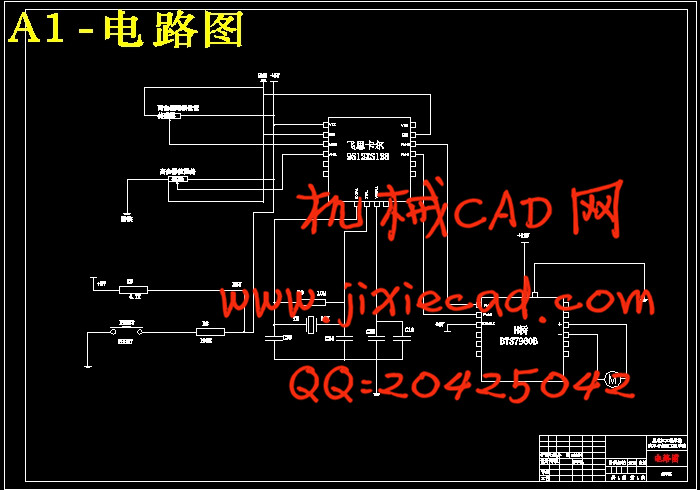设计简介
摘
随着汽车电子技术、自动控制技术的逐步成熟和汽车网络通信技术的广泛应用,汽车线控技术也逐步得到青睐和深入研究是汽车未来的发展趋势。
汽车线控技术就是将驾驶员的操纵动作经过传感器变成电信号,通过电缆直接传输到执行机构的一种系统。目前包括线控换档系统、线控制动系统、线控悬架系统、线控增压系统、线控油门系统及线控转向系统。其中线控转向系统在高级轿车、跑车及概念车上有广泛的应用,它为自动驾驶提供了良好的平台。
汽车离合器操纵形式有液压和拉线式两种。其中拉线式布置方便,摩擦损失大机械式受车架、车身变形影响大,两种机械式操纵机构的比较杆系传动优点:结构简单;成本低;寿命长;可靠性高;缺点:关节点多,摩擦损失大,不适合远距离操纵,受车身或车架的变形影响。拉线传动优点:结构简单;成本低;克服了杆系传动的不适合远距离操纵,受车身或车架的变形影响缺点;可采用吊挂式的踏板;缺点:寿命短,拉伸刚度小;拉伸变形导致增加踏板行程。
本设计针对拉线操纵式离合器设计线控操纵系统,可与原系统的功能进行切换工作。
关键词:线控离合器;H桥;PWM控制;控制策略;传感器
ABSTRACT
As automobile electronic technology , Automatic control technology gradually mature and car network communications technology is widely used , Automotive wire control technology is also gradually gain favour is car further research and the future trend of development.
Automotive wire control technology is the driver through sensor into electrical signal manipulation of action, Through the cable directly transmission to the actuator a system. Currently include wire control shift system, line control servo system, line control suspension system, Wire control the pressurization system, line oil-control door system and wire control steering system. Including wire control steering system in limousines, sports car And concept car, it is widely used for automated driving to provide a good platform.
Clutch manipulations hydraulic and farrowed type two kinds. Including farrowed type decorates convenient, Friction loss is big, By frame, body spurt type deformation great influence, Two kinds of mechanical control mechanisms of comparative bar transmission advantages: simple structure; Cost is low; Long life. High reliability; Faults: jointing, friction loss more big, do not suitable for long-distance manipulation, The body or frame by deformation. Farrowed transmission advantages: simple structure; Cost is low; Overcome the rod is not suitable for long-distance manipulation of transmission of, The body or frame by deformation faults. Can use hanging pedal; Faults: short life, stretching stiffness is small; Tensile deformation to lead to a rise in pedal stroke.
This design for farrowed manipulate type clutch design control systems, can wire with the original system function shifts.
Keywords: wire control clutch; H bridge; PWM control; Control strategies; sensor
摘要 I
Abstract Ⅱ
第1章 绪论 1
1.1 选题的目的和意义 1
1.2 线控技术现状分析 7
1.3 线控技术发展前景 2
1.4 研究内容和需解决的主要问题 3
第2章 线控离合器系统 4
2.1线控离合器控制系统 4
2.2线控离合器控制系统结构 4
2.2.1 机械式离合器结构、原理 4
2.2.2 线控离合器结构、原理 5
2.3 线控离合器系统存在主要问题 7
2.3.1 线控离合器的优点 7
2.3.2 系统存在的主要问题 8
2.4 本章小结 8
第3章 线控离合器数学模型和控制策略 10
3.1 系统建模 10
3.1.1 线控离合器机构 10
3.1.2 工作过程分析 10
3.1.3 齿轮传动及齿隙影响 10
3.2 控制策略分析 11
3.3 本章小结 12
第4章 控制系统硬件设计 13
4.1 控制系统结构 13
4.2 控制系统电路设计 14
4.2.1 单片机的选择 14
4.2.2 飞思卡尔单片机的简介及优点 15
4.2.3 信号处理电路设计 17
4.3 驱动电路设计 18
4.3.1 H桥驱动电路 18
4.3.2 PWM模块及工作原理 20
4.3.3 使能控制和方向逻辑 22
4.4 直流电机控制原理 23
4.4.1直流电机控制原理 23
4.4.2 直流电机的可逆 PWM控制电路 24
4.4.3 PID控制原理 25
4.5 本章小结 27
第5章 控制系统软件设计 29
5.1 软件系统总体分析 29
5.2 控制功能软件设计 30
5.2.1 功能子程序设计 30
5.2.2 控制功能程序编写 31
5.3 本章小结 35
结论 36
参考文献 37
致谢 38
附录 39




